33 days of sun NASA videos
For other uses, see Sun (disambiguation) and The Sun (disambiguation).
Sun
White glowing ball
True-color image taken in 2019 using a solar filter
Names Sun, Sol (/ˈsɒl/),[1] Sól, Helios (/ˈhiːliəs/)[2]
Adjectives Solar (/ˈsoʊlər/)[3]
Symbol ☉
Observation data
Mean distance
from Earth 1 AU ≈ 1.496×108 km[4]
8 min 19 s at light speed
Visual brightness (V) −26.74[5]
Absolute magnitude 4.83[5]
Spectral classification G2V[6]
Metallicity Z = 0.0122[7]
Angular size 31.6–32.7 minutes of arc[8]
0.527–0.545 degrees
Orbital characteristics
Mean distance from Milky Way core ≈26,660 light-years
Galactic period (2.25–2.50)×108 yr
Velocity ≈251 km/s (orbit around the center of the Milky Way)
≈ 20 km/s (relative to average velocity of other stars in stellar neighborhood)
≈ 370 km/s[9] (relative to the cosmic microwave background)
Physical characteristics
Equatorial radius 695,700 km,[10]
696,342 km[11]
109 × Earth radii[12]
Equatorial circumference 4.379×106 km[12]
109 × Earth[12]
Flattening 9×10−6
Surface area 6.09×1012 km2[12]
12,000 × Earth[12]
Volume 1.41×1018 km3[12]
1,300,000 × Earth
Mass 1.9885×1030 kg[5]
332,950 Earths[5]
Average density 1.408 g/cm3[5][12][13]
0.255 × Earth[5][12]
Center density (modeled) 162.2 g/cm3[5]
12.4 × Earth
Equatorial surface gravity 274 m/s2[5]
28 × Earth[12]
Moment of inertia factor 0.070[5] (estimate)
Escape velocity
(from the surface) 617.7 km/s[12]
55 × Earth[12]
Temperature Center (modeled): 1.57×107 K[5]
Photosphere (effective): 5,772 K[5]
Corona: ≈ 5×106 K
Luminosity (Lsol) 3.828×1026 W[5]
≈ 3.75×1028 lm
≈ 98 lm/W efficacy
Color (B-V) 0.63
Mean radiance (Isol) 2.009×107 W·m−2·sr−1
Age ≈4.6 billion years (4.6×109 years)[14][15]
Photospheric composition (by mass)
73.46% hydrogen[16]
24.85% helium
0.77% oxygen
0.29% carbon
0.16% iron
0.12% neon
0.09% nitrogen
0.07% silicon
0.05% magnesium
0.04% sulphur
Rotation characteristics
Obliquity 7.25°[5]
(to the ecliptic)
67.23°
(to the galactic plane)
Right ascension
of North pole[17] 286.13°
19 h 4 min 30 s
Declination
of North pole +63.87°
63° 52' North
Sidereal rotation period 25.05 days at equator
25.38 days at 16° latitude
34.4 days at poles[5]
Rotation velocity
(at equator) 1.997 km/s[12]
The Sun is the star at the center of the Solar System. It is a nearly perfect ball of hot plasma,[18][19] heated to incandescence by nuclear fusion reactions in its core. The Sun radiates this energy mainly as light, ultraviolet, and infrared radiation, and is the most important source of energy for life on Earth.
The Sun's radius is about 695,000 kilometers (432,000 miles), or 109 times that of Earth. Its mass is about 330,000 times that of Earth, comprising about 99.86% of the total mass of the Solar System.[20] Roughly three-quarters of the Sun's mass consists of hydrogen (~73%); the rest is mostly helium (~25%), with much smaller quantities of heavier elements, including oxygen, carbon, neon, and iron.[21]
The Sun is a G-type main-sequence star (G2V), informally called a yellow dwarf, though its light is actually white. It formed approximately 4.6 billion[a][14][22] years ago from the gravitational collapse of matter within a region of a large molecular cloud. Most of this matter gathered in the center, whereas the rest flattened into an orbiting disk that became the Solar System. The central mass became so hot and dense that it eventually initiated nuclear fusion in its core. It is thought that almost all stars form by this process.
Every second, the Sun's core fuses about 600 million tons of hydrogen into helium, and in the process converts 4 million tons of matter into energy. This energy, which can take between 10,000 and 170,000 years to escape the core, is the source of the Sun's light and heat. When hydrogen fusion in its core has diminished to the point at which the Sun is no longer in hydrostatic equilibrium, its core will undergo a marked increase in density and temperature while its outer layers expand, eventually transforming the Sun into a red giant. It is calculated that the Sun will become sufficiently large to engulf the current orbits of Mercury and Venus, and render Earth uninhabitable in five billion years. After this, it will shed its outer layers and become a dense type of cooling star known as a white dwarf, and no longer produce energy by fusion, but still glow and give off heat from its previous fusion.
The enormous effect of the Sun on Earth has been recognized since prehistoric times. The Sun was thought of by some cultures as a deity. The synodic rotation of Earth and its orbit around the Sun are the basis of some solar calendars. The predominant calendar in use today is the Gregorian calendar which is based upon the standard 16th-century interpretation of the Sun's observed movement as actual movement.[23]
Etymology
The English word sun developed from Old English sunne. Cognates appear in other Germanic languages, including West Frisian sinne, Dutch zon, Low German Sünn, Standard German Sonne, Bavarian Sunna, Old Norse sunna, and Gothic sunnō. All these words stem from Proto-Germanic *sunnōn.[24][25] This is ultimately related to the word for sun in other branches of the Indo-European language family, though in most cases a nominative stem with an l is found, rather than the genitive stem in n, as for example in Latin sōl, ancient Greek ἥλιος (hēlios), Welsh haul and Czech slunce, as well as (with *l > r) Sanskrit स्वर (svár) and Persian خور (xvar). Indeed, the l-stem survived in Proto-Germanic as well, as *sōwelan, which gave rise to Gothic sauil (alongside sunnō) and Old Norse prosaic sól (alongside poetic sunna), and through it the words for sun in the modern Scandinavian languages: Swedish and Danish sol, Icelandic sól, etc.[25]
The principal adjectives for the Sun in English are sunny for sunlight and, in technical contexts, solar (/ˈsoʊlər/),[3] from Latin sol[26] – the latter found in terms such as solar day, solar eclipse and Solar System (occasionally Sol system). From the Greek helios comes the rare adjective heliac (/ˈhiːliæk/).[27] In English, the Greek and Latin words occur in poetry as personifications of the Sun, Helios (/ˈhiːliəs/) and Sol (/ˈsɒl/),[2][1] while in science fiction Sol may be used as a name for the Sun to distinguish it from other stars. The term sol with a lower-case s is used by planetary astronomers for the duration of a solar day on another planet such as Mars.[28]
The English weekday name Sunday stems from Old English Sunnandæg "sun's day", a Germanic interpretation of the Latin phrase diēs sōlis, itself a translation of the ancient Greek ἡμέρα ἡλίου (hēmera hēliou) 'day of the sun'.[29] The astronomical symbol for the Sun is a circle with a center dot, ☉. It is used for
-
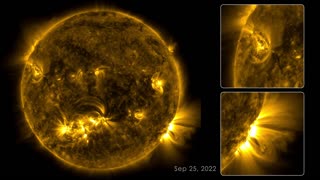 59:17
59:17
Ser007G13
1 year ago133 Days on the Sun Nasa
1 -
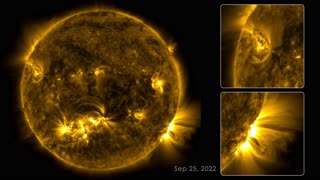 59:17
59:17
Explorethebreathtakingadvenures
10 months ago133 Days on the Sun - NASA
9 -
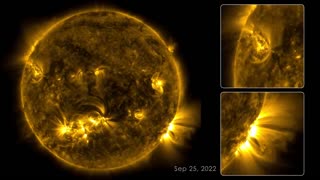 59:17
59:17
Aanwar564
10 months ago133 days on the sun by NASA
2 -
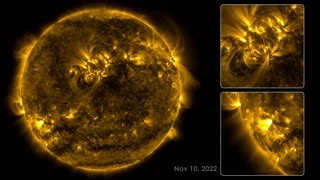 59:17
59:17
"TechFusion Entertainment"
10 months ago133 days on sun by nasa
6 -
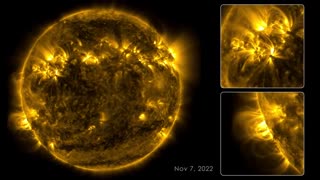 59:17
59:17
SheilMore
11 months ago133 Days on the Sun by NASA
1 -
 59:17
59:17
seattletime
10 months agonasa 133 days on the sun
9 -
 45:00
45:00
Shahzaib7311
10 months agoNASA 🚀 space video 2022
7 -
 2:18
2:18
junior586
1 year agoNASA ScienceCasts: A Sunset Sky Show
1 -
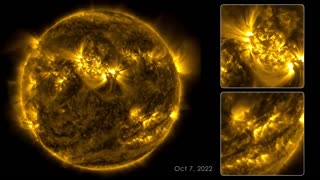 59:17
59:17
LZflokha06ZL
9 months agoNASA: 133 Days on the Sun
5 -
 1:01:17
1:01:17
The Relaxation Zone
1 year agoNASA | A Decade of Sun | 1 Hour |
201